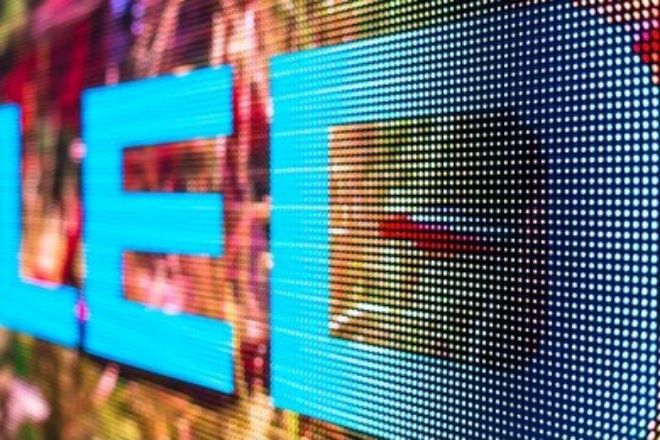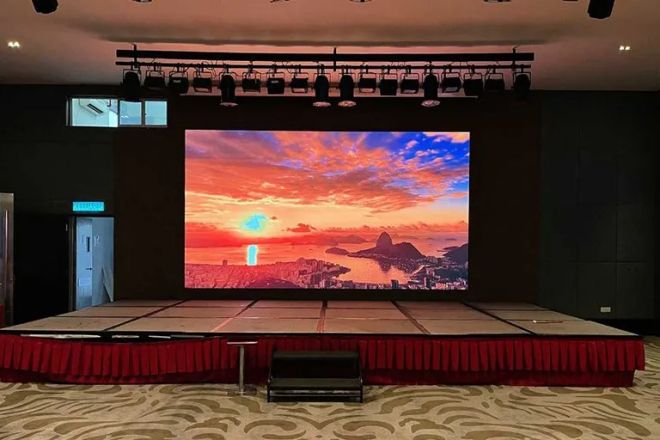Introduction

Behind the dazzling Affichage LED, there is a challenge that cannot be ignored – heat. As the core of modern visual display, every bit of heat of the LED display is directly related to the stability of its performance and the length of its life.
Have you ever wondered why these high-tech products also “boil blood”? This article will take you to the truth of LED display heating, reveal the reasons behind it, and provide you with a series of practical and effective relief methods.
1. The scientific principle of LED display heating
1). Why does the LED display heat up?
When you turn on the LED display, it starts working and glows like a small light bulb. However, the LED display is not just simply “glowing”; it is actually doing something more complicated: turning electricity into light and heat.
2). How does electrical energy turn into light and heat?
Imagine that there are many small LED lights (light-emitting diodes) in the LED display. When you power them up, it’s like giving them a little “magic energy.”
Some of this “magic energy” is very lucky to become the light we can see, illuminating the images and text on the screen. However, not all “magic energy” is so lucky; most of it actually turns into heat.
3). Why does most of the energy turn into heat?
This is because LED is not 100% perfect for converting electrical energy into light energy. Just like when we do things, there are always some places that are not done well enough, which will waste some time and energy.
The same is true for LED. When it converts electrical energy, only a small part of it turns into light, and most of it turns into heat.
4). How does heat energy affect LED displays?
If the heat generated by the LED display cannot be dissipated in time, it will become hotter and hotter, just like you don’t have air conditioning in the summer.
When the LED display is overheated, its performance may decline, such as dimming brightness, color distortion, and even damage. Therefore, we need to install a cooling system for the LED display to help it dissipate the generated heat in time and keep it within a temperature range suitable for work.
In summary, the LED display will heat up when it is working because most of the energy is converted into heat energy when it converts electrical energy into light energy and heat energy. In order to ensure the normal operation of the LED display and extend its service life, you need to do a good job of heat dissipation.
2. What are the reasons for heating the LED display?

When large electronic products like LED display screens are “working” because there are many components running inside, heating is actually a normal phenomenon, but if excessive heating or abnormal phenomena occur, for example, when you touch the LED display screen box, you will feel a clear sense of heat, it is abnormal heating! It needs to be taken seriously.
The following are some reasons for abnormal heating:
1). The heat dissipation design is not good enough
When planning the LED display, the designer may over-optimistically estimate the capacity of the heat dissipation system, fail to fully consider the long-term continuous working scenarios that the display may face, or underestimate the temperature changes in the actual use environment.
Inadequate heat dissipation design, such as insufficient heat sink area, insufficient number of fans, or insufficient speed, will cause the heat to not be dissipated into the air in a timely and effective manner. It’s like wearing a heavy coat in the hot summer.
Although it feels cool, the body cannot dissipate heat and will soon feel stuffy and uncomfortable.
2). The working environment is too harsh
The working environment of the LED display has a vital impact on its heat dissipation performance. If the display is placed in a high temperature, high humidity, or poorly ventilated environment, it is like a person trapped in a closed sauna room.
The heat cannot be effectively discharged, and it will quickly accumulate and cause the display temperature to rise. Especially when the display needs to work for a long time at high brightness, more heat will be generated inside it.
If the environment is not conducive to heat dissipation, it will form a vicious circle, making the display hotter and hotter.
3). Too much or unstable current
Current is a key factor in driving the LED display to emit light, but the excessive current is like injecting excessive energy into the body, which will make the display “unable to bear.”
In order to obtain higher brightness, the current is sometimes increased, but this will directly cause more heat to be generated inside the LED chip.
In addition, if the current is unstable, sometimes high and sometimes low, just like voltage fluctuations, it will interfere with the normal operation of the LED chip, generate additional heat, and aggravate the heating problem of the display.
This is like when refueling a car; if the oil gun is unstable, sometimes more and sometimes less, it will not only affect the refueling efficiency but also may cause damage to the car.
4). The display itself has a problem
As a complex electronic device, the LED display contains many sophisticated components and connecting lines inside. If the power supply is unstable or the line contact is poor, it will cause the display to work abnormally and then generate additional heat.
This is like a light bulb at home. If the lamp holder has poor contact, the bulb will flicker and may heat up. The failure of the display may be caused by a variety of reasons, such as component aging, damage or design defects, etc.
These problems need to be checked and solved in time to ensure the normal operation and heat dissipation performance of the display.
3. Potential risks of heating of LED display screens
1). Potential risks of heating
- Luminosité dims:
After the LED display screen is overheated, its brightness will gradually dim, just like the light bulb will dim after a long time. This is because the luminous material inside becomes weaker due to heat.
- Inaccurate colors:
High temperatures can also make the colors of the display inaccurate. For example, red may become darker, while other colors may still look the same, so the entire picture loses its original color balance.
- Equipment is easy to break:
Long-term high temperatures will cause the parts inside the display to age faster, just like mobile phones are easy to break after being exposed to the sun for a long time. This will not only affect the display effect but may also cause the display to break directly.
- Possible safety accidents:
If the LED display screen is abnormally heated for a long time, it is easy to cause the internal circuit protection layer to melt, resulting in safety accidents caused by the circuit, such as fire.
2). The necessity of effective management
- Protect the display:
Just as we need to protect our skin from sunburn, we also need to protect the LED display from high temperatures. Effective heat dissipation can keep the display cool and extend its service life.
- Maintain good results:
Controlling the temperature can ensure that the color and brightness of the display are kept in a good state, making the pictures we see clearer and more realistic.
- Save costs:
If the display often has problems due to overheating, it will need to be repaired or replaced frequently, which will cost a lot of money. Effective heat dissipation management can reduce these unnecessary expenses.
So, in order to make the LED display work better and longer, we need to pay attention to its heat dissipation problem and take appropriate measures to manage its heating.
4. Methods to relieve the heat of LED display screen

To relieve the heat of the LED display screen, it is necessary to let its heat dissipate faster and not let it stay inside. Through the following methods, we can help the display screen stay cool and extend its service life.
1). Strengthen heat dissipation design
Increase the heat dissipation area: Just like adding a heat dissipation shell to the mobile phone, add something to the display screen that can help dissipate heat, such as using metal sheets to increase the area so that the heat can be dissipated more easily.
Use good materials: Choose materials that can quickly transfer heat, such as special metal plates, so that the heat can be transferred faster.
Install a fan: Install a small fan inside the display screen and blow it continuously to help blow out the hot air inside.
2). Improve the working environment
Keep ventilation: Make sure the air around the display screen is circulating, and don’t put it in a closed corner or box.
Avoid extreme environments: Don’t let the display screen work in a place that is too hot or too humid so that it will heat up more easily.
Clean regularly: Clean the dust on the display screen frequently and keep it clean so that the heat can be better dissipated.
3). Control the current
Just right: Don’t give the display too much or too little current; just enough to make it bright so that it won’t generate too much heat.
Keep it stable: The current should be stable, not fluctuating, so that the display won’t heat up due to current changes.
4). Reasonably arrange the use time
Take turns to rest: Don’t let a part of the display stay on all the time; you can take turns to display so that each part can get a rest.
Timed shutdown: Set a time for the display to automatically rest after working for a period of time so that it won’t overheat.
5). Use advanced materials
Materials with good thermal conductivity: Just like the clothes we wear should be breathable, the display should also use thermally conductive materials to make it easier for heat to be transferred out.
Special packaging: Some advanced display screens will use special methods to encapsulate the lamp beads inside, which can also help dissipate heat.
6). Other tips
Radiation heat dissipation: Apply a layer of special paint on the outer shell of the display screen to allow heat to radiate out like light.
Use airflow: Design the shape of the outer shell of the display screen so that air can flow naturally and take away heat.
Conclusion
In summary, the heating of LED display screens during use is a complex and common problem, but we can effectively alleviate this problem through reasonable heat dissipation design, control of the working environment, optimization of the current drive, and selection of high-performance materials.
As users and maintainers of LED display screens, we should pay attention to the heating problem and regularly check and maintain the display screen to ensure that it is in good working condition.
Enfin, si vous souhaitez en savoir plus sur les écrans d'affichage LED, veuillez nous contacter.
